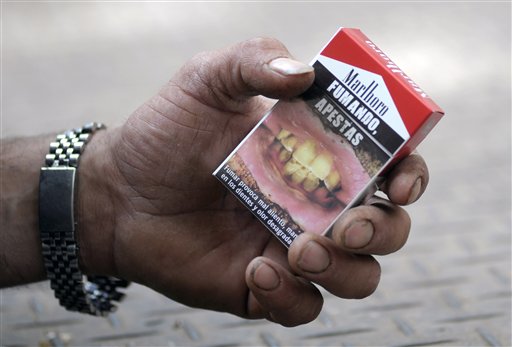
While graphic new warning labels on cigarette packs that show a diseased lung or rotting teeth may be shocking to U.S. consumers, those in countries from Egypt to Uruguay may ask: “What’s the big deal?”
The Food and Drug Administration on Tuesday released nine new labels for cigarette packs that aim to show the dangers of smoking through images such as a diseased lung and a smoker wearing an oxygen mask. But more than 40 countries around the world already require warnings as graphic as the new U.S. labels __ if not more so.
The U.S. warnings __ the biggest change to the labels in 25 years __ use mostly fear and disgust to discourage Americans from smoking. The FDA estimates the new labels will cut the number of smokers by 213,000 in 2013, with smaller additional reductions through 2031. While it’s impossible to attribute reduced smoking rates to any single cause, in Canada, Brazil, Thailand and other countries, stronger warnings have been associated with an increase in the number of smokers trying to quit.
“We are so far behind,” says Michael Cummings, chair of the Roswell Park Cancer Institute’s Department of Health Behavior. “We’re a third world nation when it comes to educating the public on the risks of smoking.”
The new warning labels include images of cigarette smoke coming out of a tracheotomy hole in a man’s neck, a mother and baby with smoke swirling nearby and a sewn-up corpse. They will take up the entire top half — both front and back — of a pack of cigarettes. They must also appear in advertisements and constitute 20 percent of each ad. Cigarette makers will have to run all nine labels on a rotating basis. They have until the fall of 2012 to comply.
Before the new labels were introduced, the U.S. had some of the weakest cigarette warnings in the world. The introduction of the graphic labels was required in a 2009 law that, for the first time, gave the federal government authority to regulate tobacco.
The U.S. first mandated the use of warning labels stating, “Cigarettes may be hazardous to your health” in 1965. The current warning labels — put on cigarette packs in the mid-1980s — say more explicitly that smoking can cause lung cancer, heart disease and other illnesses. But they are text-only blurbs found in a small box on the side of the pack.
The new labels with the graphic images, the government acknowledges, are graphic but much-needed. Tobacco use costs the U.S. economy nearly $200 billion annually in medical costs and lost productivity, the FDA said. Tobacco use also is responsible for about 443,000 deaths a year in the U.S.
“Some of the powerful images certainly are a reminder of the health risks. Some of the images like the one of the mouth with the sort of rotting, dirty teeth and the ulcerating lesion on the lip are also reminders that smoking causes disfigurement,” said FDA Commissioner Margaret Hamburg said on Tuesday at a White House briefing. “And I think that those are very powerful messages.”
The U.S is following the lead of other countries. Many have introduced graphic labels __ and some are seeing results.
Uruguay has some of the world’s strongest warning labels. The government requires that 80 percent of the front and back of all cigarettes packages be devoted to warnings. One version shows a person smoking a battery like it’s a cigarette to illustrate that both products contain the toxic metal cadmium.
In Brazil, labels feature graphic images of dead fetuses, hemorrhaging brains and gangrened feet. They also fill an entire face of a cigarette box. In a survey, 54 percent of Brazilian smokers said these gory warnings had changed their opinion on the health consequences of smoking, while more than two-thirds said the images boosted their desire to quit, according to a report by World Health Organization researchers.
Many proponents of stronger warning labels point to Canada as evidence that pictures work. Under a first-of-its-kind law passed in Canada in 2000, tobacco companies had to affix warnings about the dangers of smoking — including photos of a diseased heart or spots on the tongue from oral cancer — on cigarette packages. Following that change, nine out of ten Canadians surveyed demonstrated a deeper knowledge of the health consequences of smoking.
The smoking rate also fell to 20 percent from 26 percent. Of course, it’s impossible to know how many people kicked the habit as a result of any single regulatory measure. Canada has taken several other steps as well, introducing higher taxes, more public education and smoking bans in public places.
“We’ve now seen it happen enough times in enough different cultures to feel very confident in concluding that not only do warning labels change knowledge and beliefs, they change behavior,” says Matthew Myers, president of the Campaign for Tobacco-Free Kids, a Washington-based advocacy group.
Still, some countries lag behind in rolling out more graphic labels.
Within the European Union, a rule in place since 2001 requires all tobacco products to display two text warnings: a compulsory one stating that “tobacco kills” or “tobacco can seriously harm you and others around you” and a second, more-specific warning, such as “smoking causes fatal lung cancer.” Member states have the option to supplement the text warnings with pictures highlighting the damage smoking can do.
China has some of the world’s weakest laws on warning labels. The mandated text-only warnings are printed in small, six-point font and do not spell out specific risks. Tobacco companies can design their own labels as long as they meet these minimum requirements.
China also has the highest rates of smoking in the world. More than half of men use tobacco products, and one million smokers die each year.
___
Associated Press Tobacco Writer Michael Felberbaum Richmond, Va., contributed to this report.
___
Copyright 2011 The Associated Press.

























